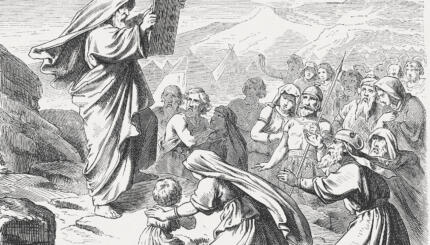Reprinted from Jewish Worship, published by the Jewish Publication Society.
On one of the
there is a large Hebrew letter, shin. This was probably meant to indicate that the scrolls inside begin with the
and not with the Ten Commandments, which at one time were also included in the tefillin. On its opposite side there is a four-pronged shin, to indicate that only four selections are in each of the tefillin and not five, as was the case when the Ten Commandments were also included. But these historic reasons were forgotten and new ones were grafted onto the mysterious letter.
One explanation is intriguing. The letter shin is combined with two other “letters” which were discovered in the tefillin, and together they form the word Shaddai-Almighty God. The two letters were found in the peculiar knots in the straps; the one on the head resembles the letter dalet and the one on the arm resembles the letter yod. The tefillin are thus to remind the Jew of his obligation to perform the commandments of Almighty God. This explanation is obviously contrived, but it has been accepted these many centuries as the real reason for the shin on the tefillin.
With the passage of the centuries the universal high regard for the rite of the tefillin increased, and new religious meanings and values were discovered in the ritual. Maimonides found that the tefillin serve a singular purpose in the religious life of the Jew. They are a holy institution leading man to humility and the fear of God. The tefillin, says Maimonides, are of a high degree of sanctity. As long as the tefillin are on a man’s head and arm, he is humble and God-fearing; [he] is not drawn into frivolity and idle talk; and does not dwell on evil thoughts, but occupies his mind with thoughts of truth and righteousness. A man should therefore endeavor to wear tefillin the whole day.

Help us keep Jewish knowledge accessible to millions of people around the world.
Your donation to My Jewish Learning fuels endless journeys of Jewish discovery. With your help, My Jewish Learning can continue to provide nonstop opportunities for learning, connection and growth.


